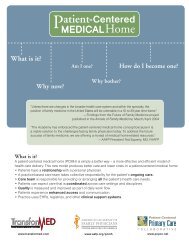New Drug Update 2009-2010 - LAFP
New Drug Update 2009-2010 - LAFP
New Drug Update 2009-2010 - LAFP
Create successful ePaper yourself
Turn your PDF publications into a flip-book with our unique Google optimized e-Paper software.
<strong>Drug</strong>s that interfere with hemostasis (eg, aspirin, NSAIDs, warfarin) X X<br />
CYP1A2 inhibitors (eg, cimetidine, ciprofloxacin, fluvoxamine)<br />
CYP2D6 inhibitors (eg, fluoxetine, paroxetine, sertraline, quinidine)<br />
CYP2D6 substrates (eg, tricyclic antidepressants, phenothiazines,<br />
propafenone, flecainide)<br />
Clomipramine<br />
Digoxin<br />
Clonidine<br />
X<br />
X<br />
X<br />
X<br />
X<br />
X<br />
RECOMMENDED MONITORING: In addition to monitoring for therapeutic response and general adverse<br />
reaction monitoring, blood pressure monitoring is advised. Blood pressure and heart rate should be<br />
determined prior to initiating therapy and periodically throughout therapy.<br />
DOSING: The milnacipran dose should be titrated over 1 week to the recommended dosage of 50 mg<br />
twice daily. Therapy should be initiated with a single 12.5 mg dose on the first day, 12.5 mg twice daily on<br />
days 2 and 3, 25 mg twice daily on days 4 through 7, and 50 mg twice daily thereafter. The dose may be<br />
subsequently increased to 100 mg twice daily based on individual response. Milnacipran may be taken<br />
with or without food; however, administration with food may improve tolerability.<br />
No dosage adjustments are necessary in patients with mild renal impairment. Milnacipran should be used<br />
with caution in patients with moderate renal impairment. In patients with severe renal impairment (CrCl<br />
less than 30 mL/min), the usual maintenance dosage should be reduced 50% to 25 mg twice daily, with<br />
increase to 50 mg twice daily based on individual patient response. Use is not recommended in patients<br />
with end-stage renal disease. 1,8 Dosage adjustments are not necessary in patients with hepatic function<br />
impairment; however, caution is advised with the use of milnacipran in patients with severe hepatic<br />
impairment.<br />
Table 9. Comparative Dosing Regimens in Fibromyalgia<br />
Normal Dose<br />
Duloxetine Initiate at 30 mg once daily. May increase to 60<br />
mg once daily after 1 week.<br />
Milnacipran Initiate at 12.5 mg on the first day. Increase to<br />
50 mg twice daily over the first week. May<br />
further increase to 100 mg twice daily.<br />
Special Populations<br />
Avoid use in patients with severe renal<br />
impairment (CrCl < 30 mL/min) or any<br />
hepatic function impairment<br />
Reduce dose by 50% in severe renal<br />
impairment. Avoid use in end-stage renal<br />
disease.<br />
PRODUCT AVAILABILITY/COST and STORAGE: Milnacipran was originally developed as an<br />
antidepressant in France, and has been available in that country since 1997. 12 Milnacipran received FDA<br />
approval January 14, <strong>2009</strong>. It is available as 12.5, 25, 50, and 100 mg film-coated tablets. Milnacipran<br />
should be stored at room temperature (25°C; 77°F), with excursions permitted between 15°C and 30°C<br />
(59°F and 86°F). The cost of Savella AWP is $127.00/60 tabs (all strengths) Vs. Cymbalta (duloxetine)<br />
60mg $140.27/30; 30mg $139.13/30 and 20mg $129.00/30 enteric coated capsules Vs. Lyrica<br />
(pregabalin) $80.10 per 30 capsules of all strengths 25,50,75,100, 150, 200,225 and 300mg<br />
68

















